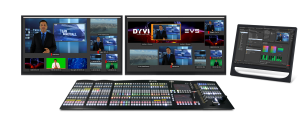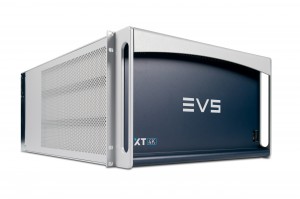SVG Europe Sit-Down: EVS’ Nicolas Bourdon discusses production challenges and training initiatives
This year’s NAB witnessed a number of innovative solutions from EVS. For example, Connected Live is a fully integrated EVS-based ecosystem that enables users to build solid and future-proof IP production infrastructures and create new multi-site collaborative workflows. This infrastructure enabled by the new Connected Agent hardware provides instant media access and exchanges between mobile production units.
But Las Vegas also saw EVS bring a new vehicle to the road – and that’s where the Sit Down with Nicolas Bourdon, SVP Marketing at EVS began…
Can you explain the rationale behind the new demonstration truck you launched at NAB?
Following last year’s successful demo tour of the US, we decided to renew the experience, but this time with a slightly larger truck and with IP infrastructure on board. This new truck is the perfect tool for demonstrating our latest solutions in a real-world setting. It is equipped with our software-defined video switcher DYVI, the XT4K live production server as well as a series of content contribution and cloud-based multimedia delivery and monitoring solutions. Consequently, we are able to show how mobile units can leverage IP technology to connect to studios and broadcast centres and thereby implement collaborative and remote production workflows.
Can you tell us more about the thinking behind the EVS/Avid alliance announced at NAB?
It is part of our objective to facilitate the exchange of media between different stakeholders and reduce the gap between live production and post. As part of our Creative Live toolset, IPLink for Avid allows MediaCentral UX users to instantly access EVS media assets, so that they spend less time searching for media and more time creating edits that make a difference to viewers.
Apart from the expansion of IP use, what changes have you noticed in sports production regarding the utilisation of your solutions?
There has been a growing need to make better use of live content, which comes down to giving access to more content, faster and to an increasing number of stakeholders, whether they are onsite or working remotely. To answer to this need we have developed solutions that facilitate the exchange of media and associated metadata across different platforms. For instance, one of our latest content contribution solutions, Xplore, gives editorial teams working from a broadcast centre the ability to access every live EVS record channel at a venue without interrupting the OB truck.
EVS has come a long way in more than 20 years. Is there one aspect of your products/services that sticks out as being the real game changer?

With a DYVI switcher you no longer need to pre-define the number of M/E boards and physical keyers with individual licenses.
If EVS is still currently the leader in live replay systems, it’s due to the architecture of our servers and the loop recording in particular. It has significantly changed the way we produce live sports.
Today DYVI is defining the new way a production switcher should operate. EVS’ video switcher is providing much more flexibility and creative capability than any other switchers in the market. This is primarily due to its architecture, which is based on a software-defined foundation that empowers GPU technology and provides virtually unlimited contextual features. As a result, the EVS switcher is bound to alter the way technical directors operate.
EVS has said “Production switching can extend well beyond the previous limits of a production switcher”. Can you amplify that statement?
With a DYVI switcher you no longer need to pre-define the number of M/E boards and physical keyers with individual licenses – layers are no longer linked to physical hardware. The EVS switcher uses GPU video processing, which allows operators to design and execute without physical boundaries of M/Es, while easily extending the capacity of the switcher with the addition of extra panels and processing modules. This means that you can increase the number of scenes and layers. This also means that you can distribute your processing according to your production needs, which no other switcher in the market offers today.
Are the colleges turning out graduates who are familiar enough with the current broadcast technology to be of immediate benefit to companies such as EVS? If not, what can be done?
EVS offers a wide-range of training courses in more than a dozen state-of-the-art training facilities across the globe. EVS also works with many universities on systems for student learning toolsets and one example is our collaboration with HBS Broadcast Academy on a live TV simulator training programme that allows directors, operators and other members of a production crew to practice their skills on our technology and in a controlled environment using real-life situations. If there are any students reading this article that are interested, I invite them to visit our training page (www.evs.com/training).
And looking ahead to the end of 2017, will we have seen any major developments in the area of 4K? If so, what will they be? If not, why not?
There is an increase in demand for UHD-4K in premium productions, but customers want to remain flexible and value the possibility of switching from 4K to HD/1080p. With our XT4K live production server, we offer just that. Four UHD-4K channels and 12 or more channels of HD/1080p. The latest generation server also comes with 10-bit HDR support for both UHD-4K and 1080p execution. In fact, all EVS live production systems have been aligned to the UHD-4K standard to support our customers’ transition in the field.



